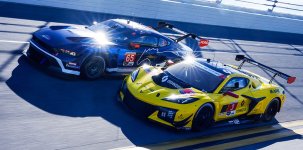teamzr1
Supporting vendor
DAYTONA BEACH, Fla. To put it politely, Joey Hand expects to see some close racing in the Grand Touring Daytona (GTD) classes in 2024.
To put it bluntly, that means occasional damage.
“There are bound to be some dive planes lost, and some body panels touched,” Hand said with a laugh. “There are going to be feelings hurt at some point. There are going to be high-fives around at some points. All that stuff that makes sport sport. Passion and emotion will be there. There is no way that passion and emotion don’t show up.”
The proof for his prediction lies with the numbers. Both GTD classes GTD and GTD PRO in the IMSA WeatherTech SportsCar Championship will experience increases in car counts when the season opens Jan. 27-28 with the 62nd Rolex 24 At Daytona.
Hand will be one of the key figures in that expansion in his role with Ford Multimatic Motorsports, which will field two new Ford Mustang GT3s in the GTD PRO class, placing the Mustang in the same category as the also-new Chevrolet Corvette Z06 GT3.R.
“The two iconic American sports cars, head-to-head,” said Hand, who will co-drive the No. 65 Mustang with Dirk Mueller. “There’s nothing better than that. What I’m most excited for is the fans. There are going to be a lot more people coming to races. They’re going to come cheer for their car, whatever car that is.”
Tommy Milner, Hand’s longtime friend and competitor, agrees. The fields in both GTD and GTD PRO will be deep and experienced. That translates into some busy, entertaining races, which translates into increased interest.
“It is hard to win races, period,” said Milner, who will team with Nicky Catsburg on the No. 4 Corvette Racing by Pratt Miller Motorsports entry. “There are so many guys doing everything they possibly can.
It’s going to be hard, but that’s what makes the success you have, hopefully, that much better.
It means that much more to drivers, the team, the manufacturer. Having success in IMSA is a huge challenge.”
Of the 43 cars that participated in testing last week at Daytona International Speedway, 27 of them were GT cars.
The pre-race entry list for the Rolex 24 At Daytona on Jan. 25-28 has 60 cars across four classes, 38 of them in the GTD and GTD PRO classes.
The return of the Mustang nameplate to American sports car racing has enormous potential, Hand said, noting the breadth and intensity of the team’s preparation.
“It’s probably going to have to prove itself a little bit, to be honest,” said Hand, who served as a primary development driver for the Mustang GT3. “We will all have to prove ourselves. If we put on good shows, people will watch.”
After seeing IMSA’s GT classes evolve and improve during the course of his 19-year career, Milner lead development driver for the Corvette Z06 GT3.R expects 2024 to be a pinnacle season.
“Every year we came back here or to Sebring, the competition level got a little bit higher and everyone worked a little bit harder,” Milner said.
“It seemed like every year was more difficult to be the best. I’m looking at next year and thinking, ‘This is going to be the hardest that it’s ever been.’”
Full fields, notable brands, skilled drivers. The potential of the new era of GTD is here, and its participants are raving about it.
“As a fan, I want to see a show, right?” Hand said. “I think you’re going to see that.”

To put it bluntly, that means occasional damage.
“There are bound to be some dive planes lost, and some body panels touched,” Hand said with a laugh. “There are going to be feelings hurt at some point. There are going to be high-fives around at some points. All that stuff that makes sport sport. Passion and emotion will be there. There is no way that passion and emotion don’t show up.”
The proof for his prediction lies with the numbers. Both GTD classes GTD and GTD PRO in the IMSA WeatherTech SportsCar Championship will experience increases in car counts when the season opens Jan. 27-28 with the 62nd Rolex 24 At Daytona.
Hand will be one of the key figures in that expansion in his role with Ford Multimatic Motorsports, which will field two new Ford Mustang GT3s in the GTD PRO class, placing the Mustang in the same category as the also-new Chevrolet Corvette Z06 GT3.R.
“The two iconic American sports cars, head-to-head,” said Hand, who will co-drive the No. 65 Mustang with Dirk Mueller. “There’s nothing better than that. What I’m most excited for is the fans. There are going to be a lot more people coming to races. They’re going to come cheer for their car, whatever car that is.”
Tommy Milner, Hand’s longtime friend and competitor, agrees. The fields in both GTD and GTD PRO will be deep and experienced. That translates into some busy, entertaining races, which translates into increased interest.
“It is hard to win races, period,” said Milner, who will team with Nicky Catsburg on the No. 4 Corvette Racing by Pratt Miller Motorsports entry. “There are so many guys doing everything they possibly can.
It’s going to be hard, but that’s what makes the success you have, hopefully, that much better.
It means that much more to drivers, the team, the manufacturer. Having success in IMSA is a huge challenge.”
Of the 43 cars that participated in testing last week at Daytona International Speedway, 27 of them were GT cars.
The pre-race entry list for the Rolex 24 At Daytona on Jan. 25-28 has 60 cars across four classes, 38 of them in the GTD and GTD PRO classes.
The return of the Mustang nameplate to American sports car racing has enormous potential, Hand said, noting the breadth and intensity of the team’s preparation.
“It’s probably going to have to prove itself a little bit, to be honest,” said Hand, who served as a primary development driver for the Mustang GT3. “We will all have to prove ourselves. If we put on good shows, people will watch.”
After seeing IMSA’s GT classes evolve and improve during the course of his 19-year career, Milner lead development driver for the Corvette Z06 GT3.R expects 2024 to be a pinnacle season.
“Every year we came back here or to Sebring, the competition level got a little bit higher and everyone worked a little bit harder,” Milner said.
“It seemed like every year was more difficult to be the best. I’m looking at next year and thinking, ‘This is going to be the hardest that it’s ever been.’”
Full fields, notable brands, skilled drivers. The potential of the new era of GTD is here, and its participants are raving about it.
“As a fan, I want to see a show, right?” Hand said. “I think you’re going to see that.”

Last edited:


